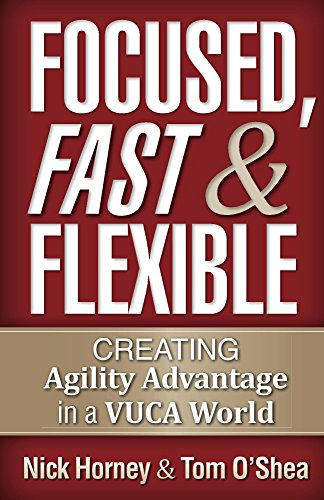Focused, Fast, and Flexible: Creating Agility Advantage in a VUCA World

Finding a way to navigate our ever-changing world is challenging to say the least. We live in unprecedented times of change. We’re facing more competition from across the globe and individual entrepreneurs who are leveraging the latest cloud and artificial intelligence options to compete with organizations of every size. To compete in today’s world, we need something like Focused, Fast, and Flexible: Creating Agility Advantage in a VUCA World.
The Argument for Change
Very few people will argue against an increasing rate of change. Even if we look at it from a content production perspective, we had to scribe everything until Gutenberg’s printing press in 1450. We started building more replicable content with the invention of the typewriter in 1870. By the 1960s, we kicked off a series of innovations decade by decade that transformed the way we communicate: the copier, the computer, the personal computer, the networking of computers, the internet, digital photography, and digital video. High speed internet access has allowed us to be educated at a distance and communicate in ways that could have not been conceived of in our grandparents’ lifetimes.
Every indication is that change is increasing in its intensity, and it’s become relentless, driving everyone to continuous change whether they like it or not. That’s why we need to develop strategies to increase our agility individually and as organizations.
Focused
It starts with finding focus. We’re distracted by thousands of advertisements every day. We are drawn to the thoughts that marketers want us to have instead of the relatively self-directed thinking of the past. (See The Hidden Persuaders for more.) For us to be effective in this world of change, we must figure out what is important – and what can be ignored.
When we’re not able to focus – or articulate our focus – people flounder or stop. They freeze because they lack the confidence to move forward. This is how creating a sense of focus allows us to move forward. If you consider that as much as 40 percent of employee work is discretionary, it’s no wonder that we need to ensure they’re focused on the right things.
OODA LOOP
Iterative cycles are an important part of learning and adapting (see Systems Thinking). The cycles that Focused, Fast, and Flexible recommends are OODA and LOOP. Both originate with Colonel John Boyd, a former Air Force pilot. “OODA” stands for Observe, Orient, Decide, and Act. “LOOP” is Locating, Orienting, Operating, Perpetuating. OODA is similar to the model that Deming recommended – Plan, Do, Study, Act (sometimes known as Plan, Do, Check, Act). LOOP is a more traditional change approach with the need to become open to the change, perform the change, and reinforce the change.
Together, these two models drive continuous improvement and anchor improvements in the organization.
Harmony
Personally and organizationally, happiness is, as Gandhi says, “when you think, what you say, and what you do are all in harmony.” This requires focus in a way that’s consistent over time and clear to everyone involved. The great trick in leadership is balancing the need for direction, focus, vision, and structure with the ability to create an environment that allows individuals to bring their own creativity to the environment.
Reading Focused, Fast, and Flexible may not lead you to your own sense of harmony, but it might just be a good start.
